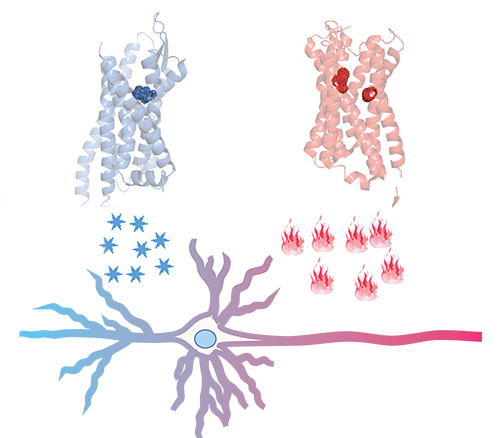Archived Content
The National Institute of Mental Health archives materials that are over 4 years old and no longer being updated. The content on this page is provided for historical reference purposes only and may not reflect current knowledge or information.
Souped-up Remote Control Switches Behaviors On-and-off in Mice
• Press Release
Neuroscientists have perfected a chemical-genetic remote control for brain circuitry and behavior. This evolving technology can now sequentially switch the same neurons – and the behaviors they mediate – on-and-off in mice, say researchers funded by the National Institutes of Health. Such bidirectional control is pivotal for decoding the brain workings of complex behaviors. The findings are the first to be published from the first wave of NIH grants awarded last fall under the BRAIN Initiative .
“With its new push-pull control, this tool sharpens the cutting edge of research aimed at improving our understanding of brain circuit disorders, such as schizophrenia and addictive behaviors,” said NIH director Francis S. Collins, M.D., Ph.D.
Bryan Roth, M.D., Ph.D. , of the University of North Carolina, Chapel Hill; Michael Krashes, Ph.D. , of NIH’s National Institute of Diabetes and Digestive and Kidney Diseases; and colleagues, debut the second generation of the tool, called DREADD – Designer Receptors Exclusively Activated by Designer Drugs – on April 30, 2014 in the journal Neuron.
DREADD 2.0 improves on a widely-adopted technology developed by Roth, a grantee of NIH’s National Institute of Mental Health, and colleagues, over the past decade. It achieves remote control by introducing a synthetic brain chemical messenger system that integrates with the workings of naturally-occurring systems.
Researchers genetically-engineer mice to have brains containing what they dub “designer receptors” in specific circuits. These are synthetic proteins on the surface of neurons that can only be activated by a matching synthetic chemical that otherwise has no biological effect – like a lock that can only be opened by a unique key. When the “designer drug” binds to its receptor, depending on its programming, it either triggers or blocks neuronal activity, thus giving researchers experimental control over the animal’s brain circuits and behaviors.
Early iterations of DREADD could only control activity in one direction – on or off – in the same population of cells. DREADD 2.0 takes advantage of properties offered by a particular type of receptor, paired with a biologically inert chemical that binds to it, to add bidirectional control. Coupled with an existing DREADD, it can be used experimentally to probe circuitry of a broad range of behaviors via sequential, on-and-off control of neurons. It’s like having two sets of locks with their own unique keys – one triggering “on,” the other turning “off.” For example, the researchers demonstrated how the improved DREAD toolkit can bi-directionally control animals’ movement and feeding behaviors.
Since DREADD effects last about an hour – as opposed to milliseconds with an alternative optical-genetic technology – it may be the tool of choice for studies of behaviors requiring prolonged control of circuitry and/or minimal invasiveness.

The updated DREADD (Designer Receptors Activated Exclusively by Designer Drugs) achieves bidirectional remote control of a neuron (bottom) and behavior by introducing a synthetic, experimental chemical messenger system into specific brain circuits in mice. It consists of a receptor protein (top) and matching inert chemical (middle) for increasing neuronal activity (red) and another set for reducing activity (blue).
Source: Bryan Roth, Ph.D., University of North Carolina
Reference
Vardy E, Robinson JE, Li C, Olsen RHJ, DiBerto JF, Giguere PM, Sassano FM, Huang X-P, Zhu H, Urban DJ, White KL, Rittiner JE, Crowley NA, Pleil KE, Mazzone CM Mosier PD, Song J, Kash TL, Malanga CJ, Krashes MJ, Roth BL. A new DREADD facilitates the multiplexed chemogenetic interrogation of behavior. Neuron, April 30, 2015.
Grants
MH105892, DA017204, DA035764, DK075087, DK075089, AA019454, AA17668, AA020911, AA02228001, AA018335, AA021312
About the National Institute of Mental Health (NIMH): The mission of the NIMH is to transform the understanding and treatment of mental illnesses through basic and clinical research, paving the way for prevention, recovery and cure. For more information, visit the NIMH website.
About the National Institute on Drug Abuse (NIDA): The National Institute on Drug Abuse (NIDA) is a component of the National Institutes of Health, U.S. Department of Health and Human Services. NIDA supports most of the world’s research on the health aspects of drug use and addiction. The Institute carries out a large variety of programs to inform policy, improve practice, and advance addiction science. Fact sheets on the health effects of drugs and information on NIDA research and other activities can be found at www.drugabuse.gov , which is now compatible with your smartphone, iPad or tablet. To order publications in English or Spanish, call NIDA’s DrugPubs research dissemination center at 1-877-NIDA-NIH or 240-645-0228 (TDD) or email requests to drugpubs@nida.nih.gov. Online ordering is available at drugpubs.drugabuse.gov . NIDA’s media guide can be found at www.drugabuse.gov/publications/media-guide/dear-journalist . You can follow NIDA on Twitter and Facebook .
The NIDDK, a component of the NIH, conducts and supports research on diabetes and other endocrine and metabolic diseases; digestive diseases, nutrition and obesity; and kidney, urologic and hematologic diseases. Spanning the full spectrum of medicine and afflicting people of all ages and ethnic groups, these diseases encompass some of the most common, severe and disabling conditions affecting Americans. For more information about the NIDDK and its programs, see http://www.niddk.nih.gov .
About the National Institute on Alcohol Abuse and Alcoholism (NIAAA): The National Institute on Alcohol Abuse and Alcoholism (NIAAA), part of the National Institutes of Health, is the primary U.S. agency for conducting and supporting research on the causes, consequences, diagnosis, prevention, and treatment of alcohol use disorder. NIAAA also disseminates research findings to general, professional, and academic audiences. Additional alcohol research information and publications are available at: https://www.niaaa.nih.gov .
